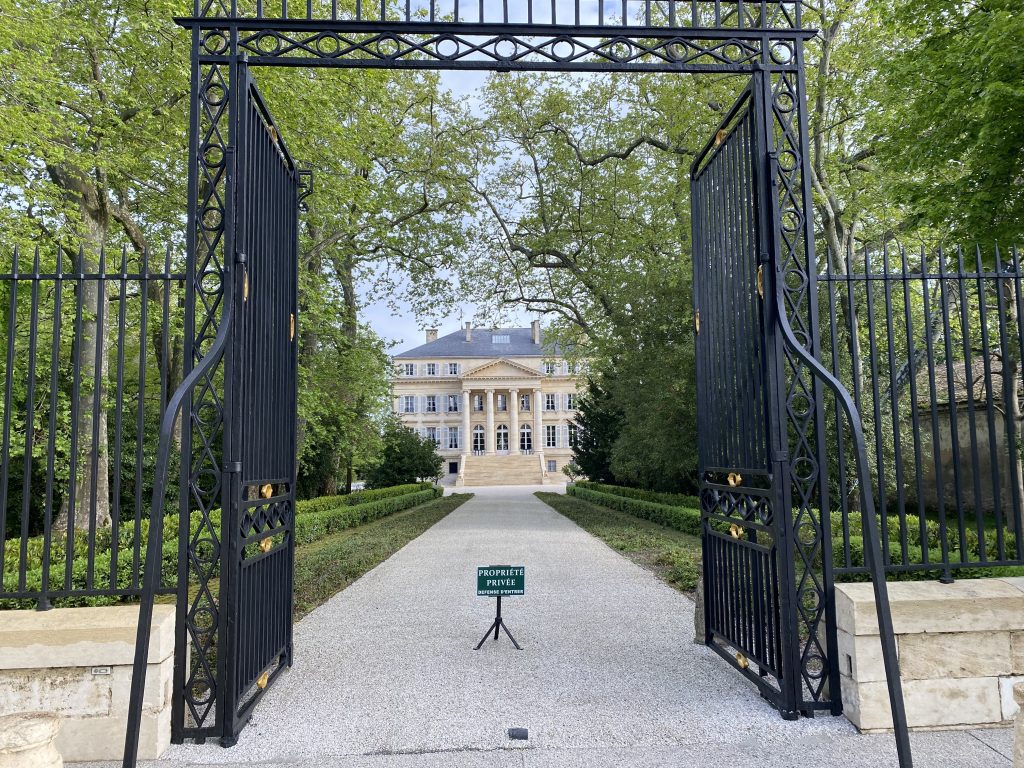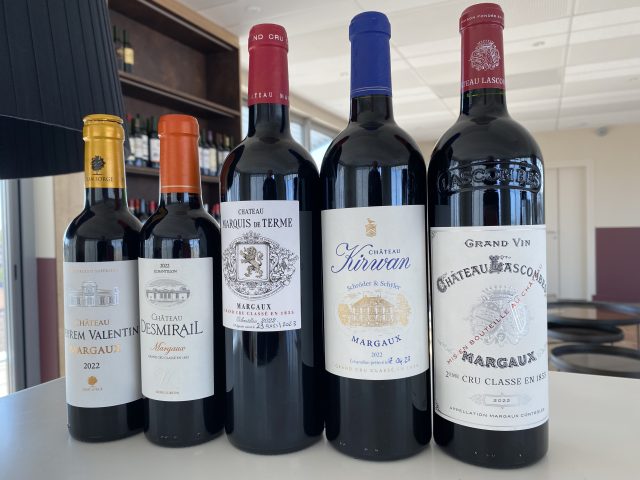Bordeaux 2022 en primeur: Margaux, impressive given the challenges of the vintage
By Colin HayMy journey south through the Médoc is largely complete as we arrive in its largest appellation, by both surface area and by the number of separate properties, Margaux. Here, the results are impressive, all the more so when the difficulties of the vintage are taken into account.

The by now habitual look at the meteorological charts suggests that Margaux did not have it easy in 2022. Along with St Julien and Pauillac it suffered the most of the region’s leading appellations from the absence of winter rainfall and it then saw less rainfall between véraison and the harvest than every other appellation save Pomerol.
Unremarkably, then, it saw less rainfall over the entire year than every appellation apart than Pessac-Léognan.
Having seen the numbers and knowing a little of Margaux’s typically ‘well-draining’ soils – relatively low in more water retentive clay and higher in gravel – I feared the worse.
|
Pre-budburst (Nov-March) |
Véraison to harvest (August-October) |
Total | |
| Margaux | 381 (-22.8%) | 58.5 (-53.0%) | 802 (-12.3%) |
| St Julien | 364 (-25.0%) | 61.3 (-47.7%) | 780 (-12.2%) |
| Pauillac | 364 (-25.0%) | 61.3 (-47.7%) | 780 (-12.2%) |
| St Estèphe | 415 (-14.6%) | 74.4 (-40.3%) | 889 (-1.1%) |
| Pessac-Léognan | 445 (-8.4%) | 57.7 (-50.7%) | 764 (-14.6%) |
| St Emilion | 558 (+14.8%) | 67.7 (-44.0%) | 886 (-1.9%) |
| Pomerol | 541 (+9.7%) | 51.2 (-57.5%) | 871 (-3.9%) |
Table 1: Rainfall during the vintage (mm, relative to 10-year average)
Source: calculated from Saturnalia’s Bordeaux 2022 Harvest report
Those fears were only reinforced by the average vineyard yield data by appellation which are presented below.
| 2018 | 2019 | 2020 | 2021 | 2022 | 10-year average | Relative to 10-year average (% change) | |
| Margaux | 37.4 | 49.2 | 36.3 | 38.6 | 31.3 | 39.7 | -21.2 |
| St Julien | 42.6 | 45.5 | 34.3 | 35.2 | 34.3 | 40.1 | -14.5 |
| Pauillac | 38.5 | 46.7 | 37.4 | 35.1 | 34.8 | 39.7 | -12.3 |
| St Estèphe | 44.6 | 49.7 | 41.2 | 40.7 | 31.5 | 43.4 | -27.4 |
| Pessac-Léognan | 36.9 | 47.2 | 34.6 | 30.7 | 35.7 | 38.5 | -7.3 |
| St Emilion (GC) | 39.7 | 43.0 | 36.7 | 27.5 | 41.2 | 37.2 | +10.7 |
| Pomerol | 36.2 | 43.0 | 39.8 | 28.9 | 32.3 | 36.1 | -10.5 |
Table 2: Average vineyard yield by appellation (hl/ha)
Source: calculated from Customs data compiled by the CIVB Service Economie et Etudes
What is clear from this is that Margaux suffered both the most significant fall in average vineyard yields (a full fifth lower than its own ten-year average) and the lowest actual average yield of any of the leading appellations (at a rather chastening 31.3 hl/ha).
The numbers don’t look good.
So it was with some surprise and delight that the first wines that I tasted from the appellation largely confounded my expectations … and with growing amazement as my expectations were recalibrated with almost every subsequent property I visited and every little group of wines that I tasted.
Yet we have to be careful not to paint too rosy a picture here. For Margaux is a big and diverse appellation. Although it has produced some excellent wines, there is no escaping its heterogeneity in 2022, with old vine Merlot on its various plateaux faring very well, whilst younger vines on less prestigious and less iconic terroirs suffered more. Strict final selections were required to grasp excellence from what little nature offered and vinifications needed to be expertly managed if tannins were not to become assertive, abrasive or even downright rustic.
But vinification styles and methods have changed a great deal in Margaux in recent years and perhaps more so than any other leading appellations its vignerons and vigneronnes, ably consulted by oenologues like Eric Boissenot, rose to the challenge they faced. The results are impressive in any context, all the more so when the difficulties of the vintage are taken into account.
Partner Content
What is also pleasing to report is the great Margaux typicity and great freshness of these wines. Continuing a trend established first in 2019 and 2020, the best wines of the appellation in 2022 are often sinuous and luminous. They are also bright, fresh and aromatically expressive, characteristics seemingly reinforced by the rather greater turn to organic and biodynamic viticulture in the appellation in recent years.

Margaux is, once again, the star of the show – and, alongside Mouton and Las Cases, a candidate for the star of the entire left-bank. It is a more substantial wine than I had imagined it might be. It reflects a quite brilliant set of choices in both the vineyard and the chai. It is destined to become a legend.
Very close behind is Palmer – also somewhat more architectural than I had anticipated that it might be. It is though, above all, brilliantly dynamic, fresh, vivid and energetic.
My expectations for Brane Cantenac are now so incredibly high that, in one sense at least, it is no surprise that it has produced such a profound wine in the 2022. Yet I have never tasted a more complete wine from this estate. It is brilliantly expressive of its superb terroir and, I am sure, a new benchmark for the property.
Rauzan-Ségla and Durfort-Vivens are now also such seasoned and consistent high-level performers that their excellence in 2022 is no surprise. Their styles are very different. But the sheer quality in each wine is unquestionable.
I could go on – and, as is sometimes pointed out to me, my tasting have a habit of doing so (at some length!). They reflect, I suppose, my enthusiasm.
So let me conclude simply just by drawing your attention to a quintet of wines that, for me, express the fabulous aromatic floral diversity of the Margaux appellation in this vintage. In each case, and perhaps most notably for Desmirail and Ferrière these are the best wines I have ever tasted from the property (a new benchmark in effect). Each is a wine for the genuine Margaux lover. My floral quintet is comprised (in strictly alphabetic order) of Desmirail, Ferrière, d’Issan, Siran and du Tertre. Each is magical in its own way.
Highlights in 2022
Best of the appellation:
- Margaux (98-100)
Truly great:
- Palmer (97-99)
- Brane Cantenac (96-98+)
- Rauzan-Ségla (96-98)
- Durfort-Vivens (95-97+)
- Giscours (95-97)
- D’Issan (95-97)
- Kirwan (95-97)
- Pavillon Rouge (94-96+)
- Ferrière (94-96)
- Malescot St-Exupéry (94-96)
Value picks:
- Ferrière (94-96)
- Cantenac Brown (93-95+)
- Desmirail (93-95)
- Marquis d’Alesme (93-95)
- Prieuré-Lichine (93-95)
- Siran (93-95)
- Du Tertre (93-95)
For full tasting notes, click here.
Please click link for db’s 2022 en primeur vintage report, along with appellation-by-appellation reviews (links updated as they become available) on Margaux, St Julien, Pessac-Leognan & Graves rouge and blanc, St Estèphe & Haut-Medoc, Pauillac, Pomerol, Saint-Émilion and Sauternes & Barsac.
Read more:
Bordeaux 2022: Miraculous majesty (thedrinksbusiness.com)
Bordeaux 2022 vintage report: The questions still to be answered (thedrinksbusiness.com)
Related news
Should Rioja increase its focus on white wine?
The 'family spirit' behind Champagne Gardet's 130th anniversary




